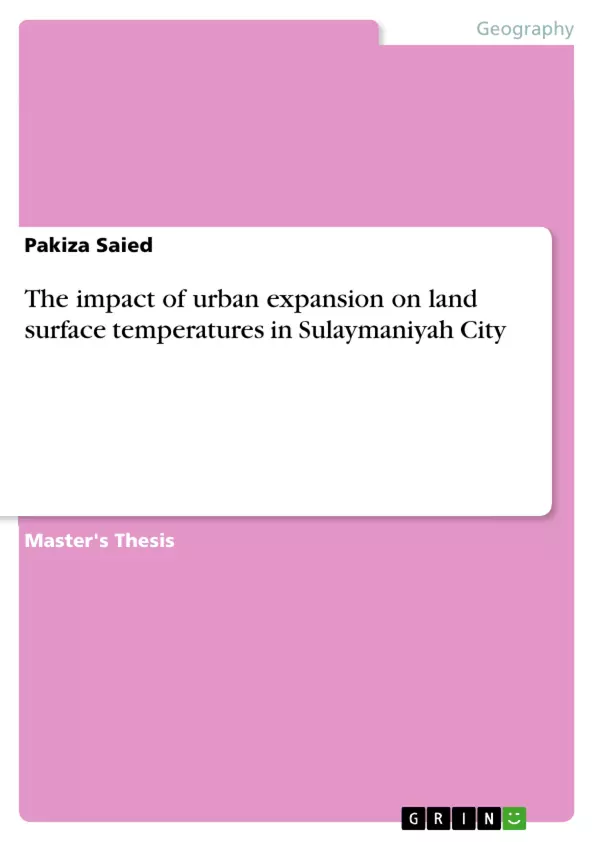This research examines the changes in land use/land cover in the city of Sulaymaniyah north of Iraq and identifies land surface temperature variations among the land cover types. The primary aim of this study is to use Landsat-5 TM imagery with GIS techniques to study and investigate the impact of urban expansion on land surface temperature (LST) for three year periods. Three Landsat 5 TM images were obtained in July 1984, August 2000 and October 2010. Land use categories were derived through the use of supervised classification techniques and the land surface temperature was obtained by computing the brightness temperature from the satellite sensor.
The result showed that between 1984 and 2010, there was a mild decrease in open and barren lands from 69.3% in 1984 to 57.2% in 2010 while the built-up areas increased from 11.5% in 1984 to 15.5% in 2000 and reached 25.5% by 2010.The political and economic changes in the study area are the main factors behind the recent urban expansion. The lowest LST readings were taken from the vegetation lands with values of 28oC in 1984, 29oC in 2000 and 34oC in 2010. The barren lands recorded the highest temperature of 38oC, 38oC and 34oC for the years 1984, 2000 and 2010 respectively. An interesting observation in this study is the fact that the urban areas where found to be cooler than its surroundings zones. This is revealed by the LST analysis conducted, with the recent increase in green spaces in the city playing a major role in cooling the temperature there. In relating NDVI to LST, the study found a strong negative correlation between them having derived correlation values of the values of (-0.70), (-0.69) and (-0.73) for 1984, 2000 and 2010 respectively. Conclusively, remote sensing and GIS proved to be very effective in studying and monitoring the relationship between urban growth and surface temperature. Recommendations were made to encourage the expansion of urban surfaces into the surrounding areas, especially barren lands, in order to cool those areas.
Inhaltsverzeichnis (Table of Contents)
- Chapter One: Introduction
- 1.1: Introduction
- 1.2: Aim and Objective of the study
- 1.3: Research Questions
- 1.4: Problem Definition
- 1.5 Structure of the thesis
- Chapter Two: Literature Review
- 2.1:The Role of Remote Sensing in Land surface Tempreture Retrieval and Application
- 2.2: Algorithms Developed for Retrieving LST
- 2.3: Related Literature on Landsat- based Land Surface Temperature Retrieval
- Chapter Three: Data and Methodology
- 3.1: Study area
- 3.2: Data Collection
- 3.3: Research method
- 3.5: Classification scheme
- 3.6: Image Classification Techniques
- 3.7: Accuracy Assessment
- 3.8: Normalized Difference Vegetation Index (NDVI)
- Chapter four: Results and Discussion
- 4.1: Result of Classification Images
- 4.3: Land Surface Temperature Retrieval
- 4.4: Spatial Distribution of LST in Sulaymaniyah city
- 4.5: Spatial Distribution of LST in 1984
- 4.6: LST Spatial Distribution in 2010
Zielsetzung und Themenschwerpunkte (Objectives and Key Themes)
This research aims to analyze changes in land use/land cover in the city of Sulaymaniyah, Iraq, and assess their impact on land surface temperature (LST). Using Landsat-5 TM imagery and GIS techniques, the study investigates urban expansion over three time periods, focusing on the relationship between land cover changes and LST variations.
- Urban expansion in Sulaymaniyah City
- Impact of land use/land cover changes on LST
- Relationship between NDVI and LST
- Use of remote sensing and GIS for urban environment analysis
- Potential for mitigation strategies to reduce urban heat island effects
Zusammenfassung der Kapitel (Chapter Summaries)
Chapter One introduces the research topic, outlining the study's objectives, research questions, and the structure of the thesis. Chapter Two reviews relevant literature, focusing on the role of remote sensing in LST retrieval and analysis, as well as existing research on Landsat-based LST studies. Chapter Three delves into the methodology, detailing the study area, data collection process, research methods, image classification techniques, and accuracy assessment procedures. Chapter Four presents the results, including the classification of land cover types, the retrieval of LST data, and analysis of its spatial distribution. The chapter also examines the relationship between NDVI and LST, exploring the potential correlation between vegetation cover and temperature variations.
Schlüsselwörter (Keywords)
The primary focus of this research is on urban expansion, land surface temperature, remote sensing, GIS, Landsat-5 TM imagery, NDVI, supervised classification, and the relationship between urban growth and heat island effects. The study utilizes empirical data and analysis to contribute to the understanding of urban environmental changes and their impact on the thermal environment.
- Citar trabajo
- Pakiza Saied (Autor), 2013, The impact of urban expansion on land surface temperatures in Sulaymaniyah City, Múnich, GRIN Verlag, https://www.grin.com/document/312165



